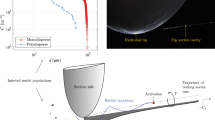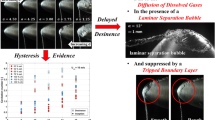Abstract
Tip vortex cavitation (TVC) inception and desinence behaviour of a NACA 0012 cross section, elliptical hydrofoil is investigated from a statistical perspective in a cavitation tunnel. Measurements were made for incidences from \(4^\circ {}\) to \(16^\circ {}\) and Reynolds numbers from \(1.0\times 10^6\) to \(2.1\times 10^6\). The statistics of TVC inception were quantified by taking repeated measurements of the time until the appearance of a tip vortex cavity for a range of fixed incidences. In other experiments, the angle of attack was continuously increased until inception and then decreased until desinence for a range of fixed cavitation numbers. The data were primarily acquired via an automated process using a laser and photodiode to detect the presence of a cavity. Measurements show that TVC inception in a nuclei deplete flow is a probabilistic process for which a large dataset is required for accurate characterisation. The probability of ingesting and activating a nucleus increases with time at a given test condition due to the increased volume of water exposed to low pressures. TVC desinence exhibits far less statistical variation than inception and is largely independent of the natural nuclei population. It does, however, exhibit hysteresis which is dependent on the topology of the cavitating flow. For the desinence of unattached cavitation, there is a small hysteresis between the inception and desinence indices. However, desinence is delayed for attached cavitation.
Graphic abstract












Similar content being viewed by others
References
Amini A, Reclari M, Sano T, Iino M, Dreyer M, Farhat M (2019) On the physical mechanism of tip vortex cavitation hysteresis. Exp Fluids 60(7):118
Amromin E (2006) Two-range scaling for tip vortex cavitation inception. Ocean Eng 33(3–4):530–534
Arndt R, Dugue C (1992) Recent advances in tip vortex cavitation research. In: Proceedings of international symposium on propulsors and cavitation, pp 142–149
Arndt RE, Keller AP (1992) Water quality effects on cavitation inception in a trailing vortex. J Fluids Eng Trans ASME 114(3):430–438
Arndt RE, Maines BH (1994) Further studies of tip vortex cavitation. In: Proceedings of 2nd international symposium on cavitation, Tokyo
Arndt R, Maines B (2000) Nucleation and bubble dynamics in vortical flows. J Fluids Eng Trans ASME 122(3):488–493
Arndt R, Arakeri V, Higuchi H (1991) Some observations of tip-vortex cavitation. J Fluid Mech 229:269–289
Baker G, Barker S, Bofah K, Saffman P (1974) Laser anemometer measurements of trailing vortices in water. J Fluid Mech 65(2):325–336
Billet M, Holl J (1979) Scale effects on viscous types of limited cavitation. In: International symposium on cavitation inception, pp 2–7
Blake Jr F (1949) The tensile strength of liquids: a review of the literature. Technical memo no. 9. Technical report, Acoustic Research Laboratory, Harvard University
Brandner P (2018) Microbubbles and cavitation: Microscales to macroscales. In: International cavitation symposium (CAV) 2018
Brandner P, Lecoffre Y, Walker G (2007) Design considerations in the development of a modern cavitation tunnel. In: 16th Australasian fluid mechanics conference
Briançon-Marjollet L, Merle L (1996) Inception, development and noise of a tip vortex cavitation. In: Proceedings of 21st symposium on naval hydrodynamics, pp 851–864
Ceccio SL, Brennen CE (1991) Observations of the dynamics and acoustics of travelling bubble cavitation. J Fluid Mech 233:633–660
Chang N, Yakushiji R, Ganesh H, Ceccio S (2009) Mechanism and scalability of tip vortex cavitation suppression by water and polymer injection. In: Seventh international symposium on cavitation—Cav2009 vol 149, pp 1–12
Chen L, Zhang L, Peng X, Shao X (2019) Influence of water quality on the tip vortex cavitation inception. Phys Fluids 31(2):023303
Danov KD, Stanimirova RD, Kralchevsky PA, Marinova KG, Stoyanov SD, Blijdenstein TB, Cox AR, Pelan EG (2016) Adhesion of bubbles and drops to solid surfaces, and anisotropic surface tensions studied by capillary meniscus dynamometry. Adv Colloid Interface Sci 233:223–239
Franc JP, Michel JM (2006) Fundamentals of cavitation. Springer, Berlin
Franklin R (1992) A note on the radius distribution function for microbubbles of gas in water. In: Proceedings of the ASME cavitation and multiphase flow forum, FED-Volume, vol 135, pp 77–85
Fruman D, Dugue C (1994) Tip vortex roll-up and cavitation. In: Proceedings of the 19th symposium on naval hydrodynamics, pp 633–654
Gavrilov L (1969) On the size distribution of gas bubbles in water. Sov Phys Acoust 15(1):22–24
Gindroz B (1995) Propeller cavitation characteristics: the practical interest of nuclei measurements in test facilities and at sea. In: Proceedings of ASME FED symposium on cavitation
Gindroz B, Billet M (1998) Influence of the nuclei on the cavitation inception for different types of cavitation on ship propellers. J Fluids Eng 120(1):171–178
Green S (1988) Tip vortices: single phase and cavitating flow phenomena. PhD thesis, California Institute of Technology
Green S (1991) Correlating single phase flow measurements with observations of trailing vortex cavitation. J Fluids Eng 113(1):125–129
Holl J (1960) An effect of air content on the occurrence of cavitation. J Basic Eng 82:941–946
Hsiao CT, Chahine GL (2005) Scaling of tip vortex cavitation inception noise with a bubble dynamics model accounting for nuclei size distribution. J Fluids Eng 127(1):55–65
Hsiao C, Chahine G (2008) Scaling of tip vortex cavitation inception for a marine open propeller. In: Proceedings of 27th symposium on naval hydrodynamics, Seoul, Korea, pp 5–10
Khoo M, Venning J, Pearce B, Brandner P, Lecoffre Y (2016) Development of a cavitation susceptibility meter for nuclei size distribution measurements. In: 20th Australasian fluid mechanics conference
Khoo M, Venning J, Pearce B, Takahashi K, Mori T, Brandner P (2020) Natural nuclei population dynamics in cavitation tunnels. Exp Fluids 61(2):1–20
Laberteaux K, Ceccio S (2001) Partial cavity flows. Part 2: Cavities forming on test objects with spanwise variation. J Fluid Mech 431:43–63
Lecoffre Y (1999) Cavitation bubble trackers. A. A. Balkema, Amsterdam
McCormick B (1962) On cavitation produced by a vortex trailing from a lifting surface. J Basic Eng 84(3):369–378
Messino D, Sette D, Wanderlingh F (1963) Statistical approach to ultrasonic cavitation. J Acoust Soc Am 35(10):1575–1583
Meyer R, Billet M, Holl J (1992) Freestream nuclei and traveling-bubble cavitation. J Fluids Eng 114(4):672–679
Mørch KA (2000) Cavitation nuclei and bubble formation: a dynamic liquid-solid interface problem. J Fluids Eng 122(3):494–498
O’Hern T, d’Agostino L, Acosta A (1988) Comparison of holographic and Coulter counter measurements of cavitation nuclei in the ocean. J Fluids Eng 110(2):200–207
Oweis G, van der Hout I, Iyer C, Tryggvason G, Ceccio S (2005) Capture and inception of bubbles near line vortices. Phys Fluids 17(2):022105
Pennings P, Westerweel J, Van Terwisga T (2015) Flow field measurement around vortex cavitation. Exp Fluids 56(11):206
Randolph K, Dierssen HM, Twardowski M, Cifuentes-Lorenzen A, Zappa CJ (2014) Optical measurements of small deeply penetrating bubble populations generated by breaking waves in the Southern Ocean. J Geophys Res Oceans 119(2):757–776
Schiebe FR (1969) The influence of gas nuclei size distribution on transient cavitation near inception. Technical report, St. Anthony Falls Laboratory
Shen Y, Gowing S, Pierce R (1984) Cavitation susceptibility measurements by a venturi. In: ASME international symposium on cavitation inception-1984, New Orleans, LA
Shen YT, Jessup S, Gowing S (2009) Tip vortex cavitation inception scaling for high Reynolds number application. In: ASME/JSME 2003 4th joint fluids summer engineering conference. American Society of Mechanical Engineers: Digital Collection, pp 233–239
Sinding KM, Hanson DR, Krane MH, Koncoski J (2018) Insight into tip vortex cavitation using velocity field measurements. In: Proceedings of 10th international symposium on cavitation (CAV2018). ASME Press
Song M, Xu L, Peng X, Tang D (2017) An acoustic approach to determine tip vortex cavitation inception for an elliptical hydrofoil considering nuclei-seeding. Int J Multiph Flow 90:79–87
Venning J, Khoo M, Pearce B, Brandner P (2018) Background nuclei measurements and implications for cavitation inception in hydrodynamic test facilities. Exp Fluids 59(4):71
Yakushiji R (2009) Mechanism of tip vortex cavitation suppression by polymer and water injection. PhD thesis, The University of Michigan
Zhang LX, Chen LY, Peng XX, Shao XM (2017) The effect of water quality on tip vortex cavitation inception. J Hydrodyn 29(6):954–961
Acknowledgements
The authors acknowledge the support of the University of Tasmania and the Defence Science and Technology Group. The authors thank AMC technical officers Mr. Robert Wrigley and Mr. Steven Kent for providing technical assistance with test facility configuration and operation.
Author information
Authors and Affiliations
Corresponding author
Additional information
Publisher's Note
Springer Nature remains neutral with regard to jurisdictional claims in published maps and institutional affiliations.
Rights and permissions
About this article
Cite this article
Khoo, M.T., Venning, J.A., Pearce, B.W. et al. Statistical aspects of tip vortex cavitation inception and desinence in a nuclei deplete flow. Exp Fluids 61, 145 (2020). https://doi.org/10.1007/s00348-020-02967-x
Received:
Revised:
Accepted:
Published:
DOI: https://doi.org/10.1007/s00348-020-02967-x




